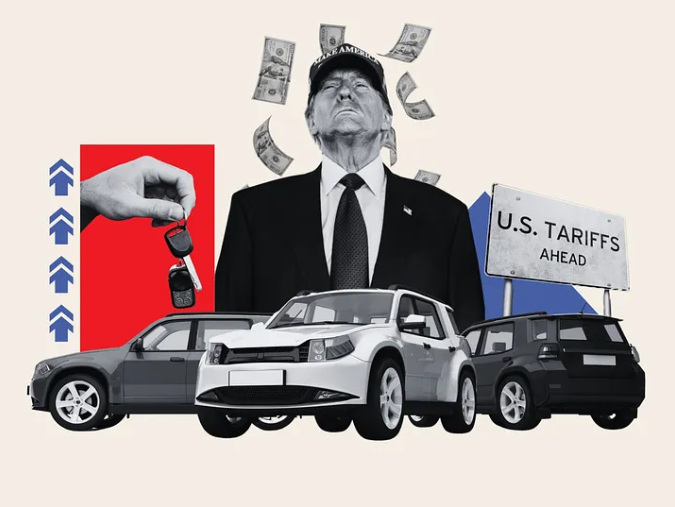
How Tariffs will Impact the Automobile Industry
Share
The Impact of Tariffs
Tariffs have long been used as a tool for economic protectionism, designed to shield domestic industries from foreign competition. However, they often bring unintended consequences. The recent implementation of 25% tariffs on automobile imports from Canada and Mexico by President Trump has sparked widespread debate. While these tariffs aim to boost American manufacturing, they threaten to increase vehicle prices, disrupt supply chains, and complicate the economic landscape for automakers and consumers alike.
The North American Auto Supply Chain
The automobile industry in North America is deeply integrated. For decades, trade agreements like NAFTA and its successor, the USMCA, have facilitated the seamless movement of car parts and assembled vehicles between the U.S., Canada, and Mexico. Many vehicles assembled in the United States contain components sourced from its neighboring countries. A Chevrolet Corvette, for instance, may have a transmission from Canada, while a Ford Super Duty truck could contain an engine manufactured in Mexico (AP News, 2025).
These international supply chains make production more efficient and cost-effective. By leveraging Canada’s steel and aluminum, Mexico’s lower labor costs, and the United States’ advanced technology, automakers have been able to produce vehicles at competitive prices. The introduction of tariffs disrupts this equilibrium by making imported components more expensive, thus increasing production costs.
Economic Consequences of Tariffs on Automobiles
One of the most immediate effects of these tariffs is the rising cost of manufacturing vehicles in the United States. According to the Anderson Economic Group, tariffs could increase vehicle costs by $1,000 to $9,000 per unit, with higher-end models seeing the most significant price jumps (TheStreet, 2025). In some cases, the additional cost per vehicle may even exceed $10,000 if automakers fail to adjust production (Reuters, 2025).
These price hikes directly impact consumers, as automakers are likely to pass at least some of the increased costs onto buyers. Investment bank Jefferies estimates that car prices could rise by about 6%, or roughly $2,700 per vehicle, on average. Given that the average new car already costs around $48,000, this additional burden could push new vehicles further out of reach for many American consumers (Reuters, 2025).
The Response from Automakers
The auto industry has strongly opposed these tariffs. Ford CEO Jim Farley has been particularly vocal about the damaging effects, stating that a long-term 25% tariff “would blow a hole in the U.S. industry that we’ve never seen” (TheStreet, 2025). Automakers rely on cross-border supply chains, and the new tariffs disrupt well-established production models.
Some automakers, like General Motors, have indicated that while short-term tariffs may not drastically affect them, long-term tariffs would force them to consider relocating production facilities (TheStreet, 2025). The uncertainty surrounding trade policies also discourages long-term investments in U.S. manufacturing, as companies hesitate to commit to major changes without a stable regulatory environment.
Potential Industry Adjustments
To cope with these new tariffs, automakers have several potential strategies:
- Absorbing Costs: Some companies may choose to absorb part of the tariff costs rather than passing them entirely onto consumers. However, this strategy is unsustainable in the long run.
- Relocating Production: If tariffs remain in place for an extended period, companies may move production facilities to the U.S. to avoid the tariffs. However, this process is costly and time-consuming.
- Stockpiling Parts: In anticipation of tariffs, some manufacturers have increased their inventory of key components to delay the financial impact.
- Raising Prices: Ultimately, consumers are likely to see higher car prices, as automakers adjust to the increased costs.
Broader Economic and Political Implications
The effects of these tariffs extend beyond the auto industry. Tariffs on steel and aluminum, key materials for vehicle production, also contribute to higher manufacturing costs. Additionally, other countries may retaliate with their own tariffs, affecting American exports. Canada and Mexico have historically responded to U.S. tariffs with their own trade restrictions, which could hurt American manufacturing and agriculture sectors (AP News, 2025).
Furthermore, the political motivations behind these tariffs add to the uncertainty. While they were initially introduced as a response to border security and drug enforcement concerns, it remains unclear whether they will be lifted once those issues are addressed. The lack of a clear long-term policy makes it difficult for businesses to plan ahead (Reuters, 2025).
Where do we go from here
The 25% tariffs on automobile imports from Canada and Mexico highlight the complexity of trade policy and its impact on industry and consumers. While the goal may be to encourage domestic manufacturing, the unintended consequences include higher vehicle prices, supply chain disruptions, and economic uncertainty. Automakers, analysts, and consumers will be watching closely to see how the industry adapts and whether policymakers will reconsider the long-term viability of these tariffs. As history has shown, trade restrictions often lead to unintended ripple effects, and the automobile industry is now navigating one of its most significant challenges yet.